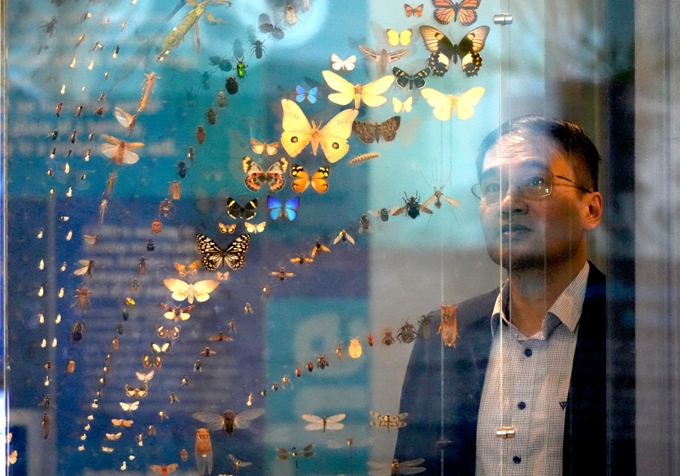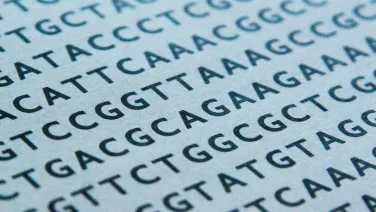Genomics software a weapon of choice in war against COVID-19

The Australian Museum announced today that Dr Minh Bui from the ANU College of Engineering, Computing and Cybernetics (CECC) and Dr Robert Lanfear of the ANU Research School of Biology are finalists for the 2023 Eureka Prize for Excellence in Research Software.
He has been an indispensable leader in humanity’s war against COVID-19. But outside the highly technical fields of biomedical research and bioinformatics software, few people know of Dr Bui. Now that's about to change.
Dr Bui’s invention IQ-TREE is an open source software tool that allows scientists to synthesize enormous volumes of genetic data to map the evolutionary trees of biological entities — a process called phylogenomic inference.
In response to the global pandemic, the software was deployed around the globe for contact tracing and for detecting variants arising from mutations in the virus. IQ-TREE played a key role in identifying the Delta variant many months before it reached Australian shores.
A matter of life and death
Dr Bui and his team were a few months into the development process for IQ-TREE 2 when SARS-CoV-2 (the virus that causes COVID-19) was identified in December 2019. The global scientific community leapt headlong into a genomic sequencing effort on an unprecedented scale. IQ-TREE wasn’t perfect, but it was the best tool available to cope with the deluge of genetic data.
Before the pandemic, Dr Bui had set aside a portion of his time for supporting the IQ-TREE user community, answering an average of two enquiries per day. But as the virus began seeding in populations around the world, the volume of questions increased to the point that Dr Bui became overwhelmed. Mindful of the software’s new importance, he sacrificed social and leisure activities to spend the majority of his time in the lab.
“Because of the lockdowns, our team could no not work together in person," Dr Bui said. "However, IQ-TREE was being used by many researchers to study the evolution of this virus, which helped us make improvements faster."
Dr Bui and his team published IQ-TREE 2 in May of 2020. It could infer an evolutionary tree from 17,000 COVID sequences in only three minutes, whereas version 1 had required 37 hours to do the same. It was a breakthrough.
More than 1.5 million genomes for SARS-CoV-2 had been made publicly available. That number ballooned to 3 million in the 10 weeks that followed, with more than 10,000 added each day.
In all, the two versions of the software were downloaded more than 50,000 times in 2020 and Dr Bui was subsequently named to the 2021 list of the world's most Highly Cited Researchers.
Roots of the tree
Dr Bui first conceived of the idea for IQ-TREE in 2011 while working at Max Perutz Labs in Vienna, Austria. He was frustrated by the limitations of the state-of-the-art applications at the time. “Some applications were fast but not so accurate, and some were more accurate but slow. So my goal was to have something both fast and accurate,” he said.
IQ-TREE was then developed at the Center for Integrative Bioinformatics Vienna by Dr Bui and colleagues Lam-Tung Nguyen, Heiko A. Schmidt, Arndt von Haeseler. In November of 2014, the team published a paper introducing IQ-TREE 1.0.
“I never imagined that it would become so popular,” Dr Bui said. IQ-TREE quickly became one of the two most widely used tools for phylogenetic inference by maximum likelihood.
“I think the success was because IQ-TREE was not just designed as a scientific software. Instead we applied a lot of industrial standards in software development to make it very user friendly,” he said.

Dr Robert Lanfear of the ANU Research School of Biology had been impressed by IQ-TREE 1.0, but beyond that it was “Minh's expertise and enthusiasm for making phylogenetics better” that inspired Prof Lanfear to recruit him to come to ANU.
Dr Lanfear said he could not have foreseen the full significance of Dr Bui’s work at the time. “But, it was already very clear that IQ-TREE was one of a very small number of leading pieces of software in the field.”
Dr Bui said that the combination of international prestige and cross-disciplinary collaboration lured him to Australia. “I saw many scientists working in the relevant field of evolutionary biology and I wanted to broaden my research,” Dr Bui said.
Dr Bui accepted the ANU research fellowship in 2018 and, among other projects, began collaborating with Dr Lanfear on IQ-TREE. “Many ideas for IQ-TREE came from my fruitful discussions with him,” Dr Bui said.
Dr Biu spent a year at the ANU School of Biology before being hired by CECC in 2019. Dr Lanfear said he was “very happy” to lose him. Their collaboration would continue, now with the resources and expertise of the ANU School of Computing.
“My funding for Minh's position was fairly short term,” Dr Lanfear explained. “Ultimately I just want the best for Minh, and his move to Computing represented a step up for his career in allowing him to start his own research group, and, it improved the chance that ANU will get to keep him for longer — hopefully indefinitely.”
Dr Bui said the IQ-TREE project relies heavily upon School of Computing colleagues Dr Giuseppe Barca, who can address high performance computing demands, and James Barbetti, a software engineer in Bui’s lab.
Dr Bui believes his work has benefited tremendously from the interdisciplinary environment at the ANU. “Nowhere else would be comparable,” he said.
Next steps
Dr Bui and his team are on a mission to enable real-time genomic epidemiology during ongoing outbreaks such as COVID-19 and develop IQ-TREE 3.0 complete with updates to address feedback from hundreds of scientists who contacted them during the pandemic.
The work will be jointly conducted between the ANU School of Computing and School of Biology, where Dr Lanfear will be the main point of contact. Dr Bui said the School of Biology has a very strong department in ecology and evolution with well-known academics such as Craig Moritz, Lindell Bromham, Gavin Huttley, Michael Jennions, and Scott Keogh.
“The idea is that computer scientists will develop and implement new models and methods while biologists cover data analysis,” Dr Bui said, anticipating that Amanda Barnard and Yu Lin — of the newly established computational science cluster — will be invaluable contributors.
“In the next couple of years I think we'll make big progress on 'real time' phylogenetics, where we continuously update phylogenetic trees for use in public health situations like SARS-CoV-2,” said Dr Lanfear.
The team also expects to make progress on accounting for recombination and hybridisation thanks to a grant from the Australian Research Council (ARC), and on estimating better models of evolution that more accurately reflect reality. And Dr Bui’s PhD student Nhan Trong Ly is extending IQ-TREE so that it can simulate datasets.
This article was first published by the ANU College of Engineering, Computing and Cybernetics.




